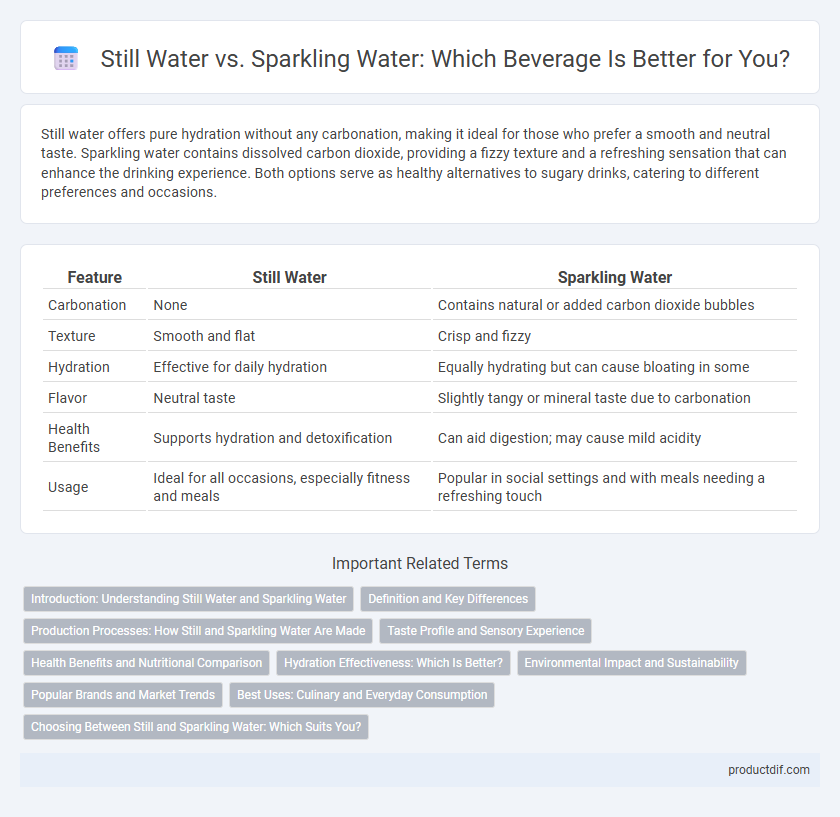Still water offers pure hydration without any carbonation, making it ideal for those who prefer a smooth and neutral taste. Sparkling water contains dissolved carbon dioxide, providing a fizzy texture and a refreshing sensation that can enhance the drinking experience. Both options serve as healthy alternatives to sugary drinks, catering to different preferences and occasions.
Table of Comparison
| Feature | Still Water | Sparkling Water |
|---|---|---|
| Carbonation | None | Contains natural or added carbon dioxide bubbles |
| Texture | Smooth and flat | Crisp and fizzy |
| Hydration | Effective for daily hydration | Equally hydrating but can cause bloating in some |
| Flavor | Neutral taste | Slightly tangy or mineral taste due to carbonation |
| Health Benefits | Supports hydration and detoxification | Can aid digestion; may cause mild acidity |
| Usage | Ideal for all occasions, especially fitness and meals | Popular in social settings and with meals needing a refreshing touch |
Introduction: Understanding Still Water and Sparkling Water
Still water is natural or purified water free from carbonation, offering a pure and neutral taste preferred for hydration and cooking. Sparkling water contains dissolved carbon dioxide, creating effervescence that appeals to those seeking a refreshing, bubbly alternative. Both types provide essential hydration but differ in texture and sensory experience, influencing consumer choice.
Definition and Key Differences
Still water is natural water that contains no carbonation, offering a pure and neutral taste often sought for hydration and cooking. Sparkling water, infused with carbon dioxide gas, features effervescence and a slightly tangy flavor, making it a popular choice for refreshing consumption or as a mixer in beverages. Key differences include carbonation presence, taste profile, and the common uses, where still water is preferred for simplicity and sparkling water for its fizzy experience.
Production Processes: How Still and Sparkling Water Are Made
Still water is typically sourced from natural springs or purified through filtration methods such as reverse osmosis or distillation, ensuring minimal impurities and a neutral taste. Sparkling water undergoes a carbonation process where carbon dioxide gas is infused under pressure, creating its characteristic bubbles and slightly tangy flavor. Both production methods prioritize maintaining water purity, but carbonation differentiates sparkling water in texture and sensory experience.
Taste Profile and Sensory Experience
Still water offers a clean, neutral taste profile with a smooth mouthfeel that complements meals without overpowering flavors. Sparkling water delivers a crisp, effervescent sensation characterized by bubbles that enhance refreshment and add a tingling texture on the palate. The carbonation in sparkling water intensifies subtle mineral notes, creating a lively sensory experience distinct from the calm purity of still water.
Health Benefits and Nutritional Comparison
Still water provides essential hydration without added calories, sugars, or sodium, making it optimal for maintaining electrolyte balance and supporting metabolic functions. Sparkling water contains dissolved carbon dioxide, which may aid digestion and promote a feeling of fullness, but some varieties include added sodium or artificial flavors that can affect overall nutritional value. Both still and sparkling water are calorie-free and hydrating, yet still water is generally preferred for individuals seeking to minimize sodium intake and avoid potential dental enamel erosion linked to carbonation.
Hydration Effectiveness: Which Is Better?
Still water provides superior hydration effectiveness due to its pure, uncarbonated nature, allowing faster absorption and optimal fluid replenishment. Sparkling water contains carbon dioxide, which can cause bloating or a feeling of fullness, potentially slowing down consumption and hydration. For efficient rehydration, especially during intense physical activity or heat exposure, still water remains the preferred choice.
Environmental Impact and Sustainability
Still water generally has a lower environmental impact than sparkling water due to the absence of carbonation processes, which require additional energy and resources. Sparkling water production often involves increased packaging to preserve carbonation and may generate more waste, contributing to a larger carbon footprint. Sustainable choices favor still water sourced responsibly to minimize water extraction and reduce plastic usage.
Popular Brands and Market Trends
Popular brands in the still water segment include Dasani, Aquafina, and Evian, while Perrier, San Pellegrino, and LaCroix dominate the sparkling water market. Market trends indicate a growing consumer preference for flavored sparkling water driven by health-conscious choices and demand for low-calorie beverages. The sparkling water category experiences higher growth rates compared to still water, fueled by innovation in natural flavors and eco-friendly packaging.
Best Uses: Culinary and Everyday Consumption
Still water is ideal for everyday hydration and culinary applications that require a neutral taste, such as cooking rice or making broths, as it does not alter the flavor of dishes. Sparkling water complements meals by cleansing the palate and enhancing the sensory experience of rich or fatty foods, making it a preferred choice in fine dining and social occasions. Both types provide hydration benefits, but their best uses depend on culinary context and personal preference for texture and taste.
Choosing Between Still and Sparkling Water: Which Suits You?
Choosing between still and sparkling water depends on personal preference, dietary needs, and occasion. Still water is hydrating, calorie-free, and ideal for everyday consumption, while sparkling water offers a fizzy texture with a refreshing taste that can enhance digestion and serve as a soda alternative. Those sensitive to carbonation or seeking gentle hydration typically prefer still water, whereas sparkling water suits individuals looking for a flavorful, bubbly option without added sugars.
Still Water vs Sparkling Water Infographic

 productdif.com
productdif.com